A Complete Guide to Virtual Instructor-Led Training (VILT)

Sure, virtual instructor-led training (VILT) courses have declined recently as the world continues to move further away from the pandemic. However, it remains a top choice for IT, desktop application, and compliance training. A 2024 Training Industry Report shows that large companies use VILT 39% of the time, making it their preferred training method.
VILT combines live instruction with the flexibility of online learning. It keeps corporate training interactive and engaging while making it easier for employees to learn from anywhere.
However, running an effective VILT session takes more than just creating an online classroom setting. You need the right structure, tools, and approach to make it work. In this guide, we’ll break down VILT’s meaning, why it’s effective, and how to deliver it successfully.
Virtual Instructor-Led Training’s Meaning
Virtual instructor-led training (VILT) is a training method that takes place online in a virtual setting where the instructor and learner can interact in real time. It mimics a classroom experience but is held on video platforms like Zoom.
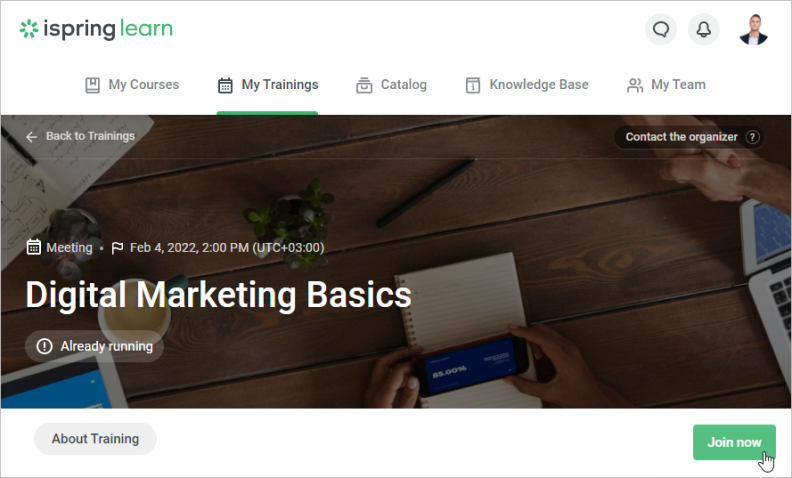
Combine virtual instructor-led training and eLearning with iSpring Learn for a blended learning approach.
What’s the Difference Between VILT and Traditional Instructor-Led Training?
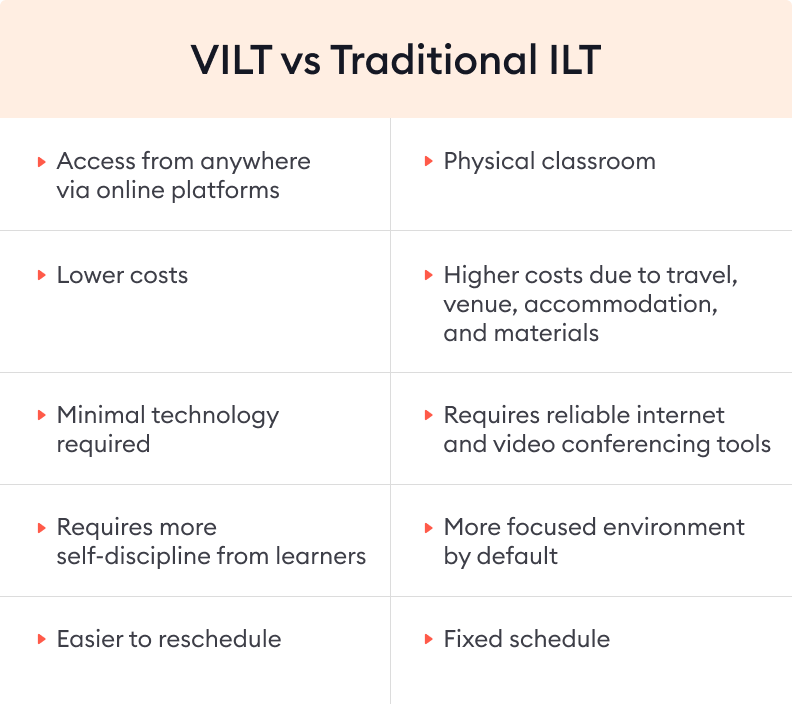
If you’re planning a switch from traditional Instructor-Led Training (ILT) to a virtual format, you’re probably wondering what changes it will bring to your organization and the training itself. So, here are the key differences between VILT and ILT:
- Physical presence vs. virtual presence. In traditional ILT, instructors and learners are in the same room. This fosters a sense of community by enabling them to interact freely, make eye contact, and interpret body language. VILT participants, on the other hand, use technology to connect. Visual cues are limited to what’s on the screen, and physical presence is replaced by a digital connection.
- Mode of training delivery. The different interaction styles also change the way you deliver the training. ILT relies on in-person lectures, handouts, whiteboard demos, and group discussions, where the instructor can monitor progress right beside you. Virtual training, on the other hand, uses screen sharing, breakout rooms, and digital materials.
- Cost considerations. In-person classroom training costs more because of venue rental, travel, materials, food, and sometimes accommodation. VILT saves money by removing the need for a physical location or travel, so it’s easier — and less expensive — for organizations to reach a wider audience.
- Learning environment. Instructor-led training programs take place in classrooms designed for learning with few distractions, so that learners can focus fully on the training. Meanwhile, you can join a virtual training session from anywhere, like home or work, but distractions can arise. As a result, learners need to manage their environment, which takes more discipline but offers comfort and convenience.
- Adaptability. ILT takes more time to plan because you need to schedule, book venues, and arrange travel, which means it’s difficult to make last-minute changes. VILT is easier to reschedule, adapts better to unexpected changes, and can handle different time zones with ease.
Benefits of Virtual Instructor-Led Training
So, you see, businesses have a lot to gain from VILT. Some of these training benefits are:
For trainers
- Cost reduction. VILT helps companies save money by cutting travel, lodging, and one-time course costs. This enables employees to learn from anywhere without significant work disruptions.
- Scalability. Since there are no space limits, businesses can quickly adjust and expand their training courses to include more participants.
- Precise trackable progress. VILT software has built-in tracking tools that can measure and display key metrics like attendance and learning comprehension.
For learners
- More upskilling opportunities. With 71% of employees eager to update their skills, VILT gives you the option to access high-quality upskilling and reskilling training programs around the globe. This is particularly beneficial for teams operating in different countries. You can also record these sessions for future use.
- Flexibility and convenience. Learners can join VILT sessions from anywhere, which gives them maximum flexibility and convenience. This training method also supports self-paced learning through recorded sessions. Moreover, virtual training caters to different learning styles through interactive elements, so employees stay engaged and learn in the way that works best for them.
- Interaction with experts and diverse voices. Virtual training allows people to learn from experts with different backgrounds and experiences, including those who are hard to get on site due to busy schedules. It also makes learning more accessible for those with physical or learning challenges by offering flexible options, like extra time for quizzes and screen-reader-friendly content.
Challenges of Virtual Instructor-Led Training
Despite these benefits, VILT is far from perfect. Like any training method, it has its fair share of downsides. Here are some of them.
Learner engagement
Remote training needs to be learner-centric, prioritizing learner engagement above everything else. Since instructors can’t rely on body language, eye contact, or physical presence to engage participants, they can struggle to assess understanding in real time.
One big challenge is visibility — if learners and instructors can’t see each other, it’s easy for participants to feel disconnected or disengaged. Plus, the endless distractions of a home environment — emails, phone calls, background noise, kids, pets — can hamper the learning process.
If you fail to create interactive content using different media formats, chances are your learners will get bored or distracted.
Heavy reliance on technology
The entire VILT process depends on a stable internet connection (with a minimum speed of 15-25 mbps) and suitable devices like a computer, laptop, camera, and microphone.
You need to make sure learners and instructors have the right internet speed and devices for a smooth lesson. If they don’t have access to them, you may need to provide the necessary equipment to avoid disruptions.
Virtual Instructor-Led Training Examples
VILT can be conducted in different formats to suit various learning goals and needs. Some of the most common ones include:
- Synchronous 1:1 sessions happen in real time, giving learners personal attention and a custom learning plan. This type of VILT is most useful for those who handle tasks involving personal guidance, quick feedback, and complex skills, like computer software or coding.
- Small group training sessions usually have from 5 to 15 participants who can interact directly with the instructors. This allows them to give direct feedback, encourage teamwork, and ultimately create a supportive learning space.
- Interactive workshops include activities like group discussions and hands-on exercises, not just lectures.
- Live webinars are real-time sessions during which instructors teach a large group. Participants can ask questions in the chat, but interaction is limited.
Tools You’ll Need for Virtual Instructor-Led Training
We know virtual training relies on technology, but which tools? Here is the software you need to deliver VILT programs.
Video conferencing tools
Instructors typically conduct virtual classes on video conferencing platforms like Zoom, Google Meet, and Microsoft Teams.
Ideally, the video conferencing software should be easy to set up and come with the following features:
- Screen sharing
- Group and individual chat
- “Raise hand” option
- Polls or surveys
- Breakout rooms
As a host, you can also use these tools to see who has joined, mute or unmute them, log attendance, monitor their activity (through screen sharing), and gather feedback in real time.
Learning management systems (LMSs)
To run an effective VILT-based program, a video meeting tool isn’t enough. You also need a learning management system (LMS) — a central hub that helps you organize, store, and deliver training materials. It makes training easier by tracking learner progress, managing content, and creating a structured learning experience.
With the right LMS, you can schedule sessions, enroll learners, and automate key tasks like sending meeting links and reminders, tracking attendance, and managing follow-up assessments.
The good news is that almost all LMS software can integrate with different video conferencing tools.
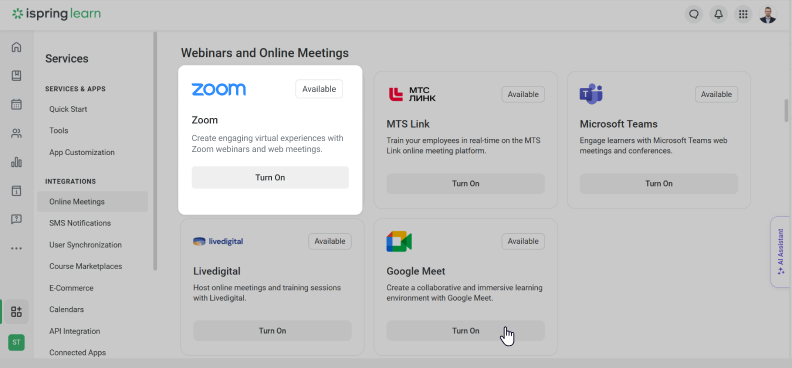
The iSpring Learn LMS integrates with Zoom, Google Meet, Microsoft Teams, and more.
Interactive whiteboard
Also known as smartboards, virtual whiteboards are online collaboration tools that are used to write, draw, and collaborate in real time. Instructors can use them to share images, videos, and presentations with the entire class, while learners add notes, brainstorm ideas, and work on group projects.
Interactive whiteboards like Miro and Google Jamboard allow learners to annotate content, solve problems together, and plan assignments, making VILT programs more effective and fun.
How to Implement VILT Successfully
With so many tools to manage, setting up a VILT model might seem overwhelming at first, but it’s easier than you think. Here are some key things to focus on to make sure everything runs smoothly:
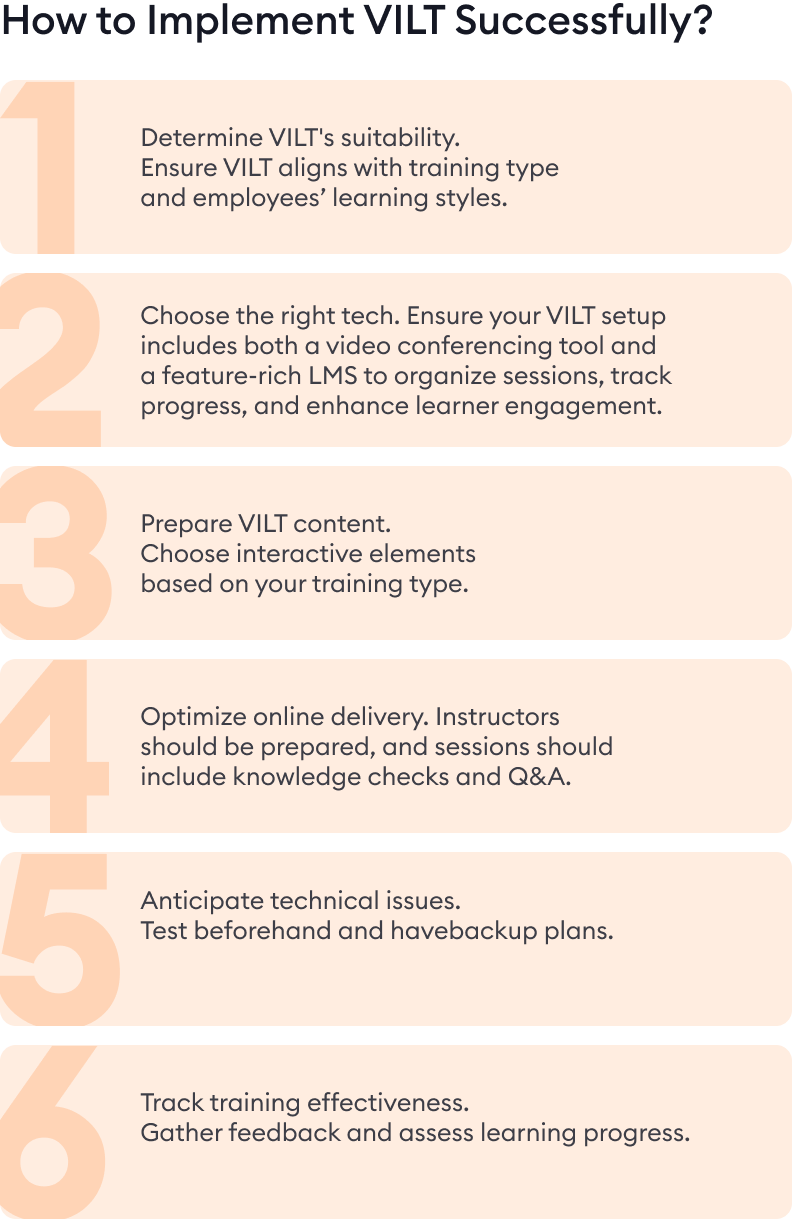
Make sure VILT is the right method for your training program
Before preparing a VILT program, it’s important to understand what you want to train your employees for. For example, VILT isn’t the best choice for hands-on training, like operating machinery or performing surgery.
You also need to consider your audience. Not all learners have the same learning styles. So, you need to analyze their feedback and preferences to understand if VILT is the best way to train them.
Choose the right technology
Once you decide that VILT is the right choice, check your current tech setup.
Do you have the appropriate software, like a video conferencing platform and LMS, to run the training? And if you do, do they have the features that are required to support VILT sessions?
As previously mentioned, a video conferencing tool alone might not be enough. That’s why most businesses pair it with an LMS. Think of an LMS as the backbone of your training program — it keeps everything organized, tracks progress, and makes sure learners receive the learning outcomes they signed up for. Without the right features, the VILT can quickly become chaotic and harder to engage with.
So, what makes an LMS great for VILT? The right one should allow you to:
- Schedule and organize VILT programs for different time zones or learner groups.
- Allow learners to enroll through self-registration so they can choose the best time.
- Send automatic reminders and reduce no-shows with timely notifications.
- Track attendance by monitoring sign-ins and participation.
- Provide a central resource hub to store handouts, videos, and other course materials for easy access.
- Run pre- and post-session quizzes and assessments to measure learning.
- Generate custom reports to track learner progress and identify areas for improvement.
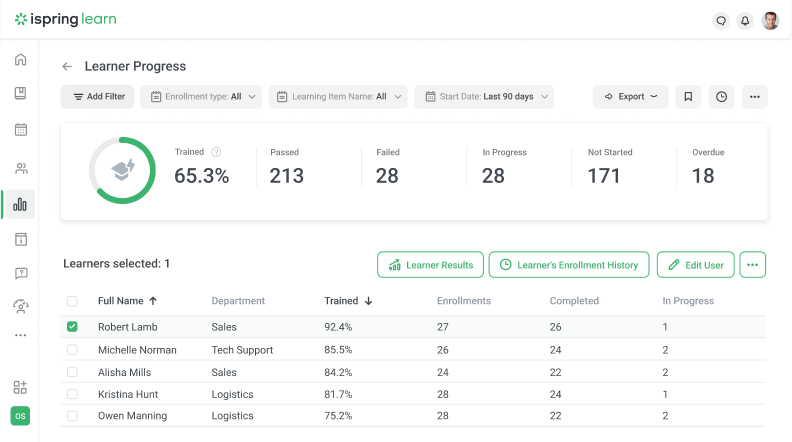
iSpring Learn provides automated reporting, allowing you to monitor your learners’ progress.
iSpring Learn LMS
Take iSpring Learn, for instance — an LMS that utilizes Zoom and Microsoft Teams integrations to seamlessly incorporate VILT sessions into online courses. Plus, it comes in a single ecosystem with iSpring Suite, a simple yet powerful tool for creating eLearning courses to support VILT sessions.
Key features
- Interactive role-plays, quizzes, and polls
- Automated reports and analytics to track attendance and progress
- Rich user management tools to personalize learning
- Course builder and a library of pre-made courses
- Mobile app to learn on the go
You can try iSpring Learn during a 30-day free trial or request a live demo.
Get your VILT content ready
Now that you’ve gathered your tools, it’s time to prepare your training material. But here’s the thing — VILT content is different from that of in-person training and self-paced online courses.
In a classroom, trainers adjust the lesson based on live feedback. In self-paced learning, people progress through the material on their own. VILT is somewhere in between — it needs to engage learners in real time through interactive content without being too much to handle.
Instead of long lectures, use videos, quizzes, polls, and group activities like discussions or role-plays. These media formats can keep learners focused, help them apply what they learn, and avoid screen fatigue.
Now, you need to be careful here — whichever activities you include must complement the type of training you’re providing. For example, role-plays and real time Q&As are highly effective for sales training but not so much so for software training.
Prepare for delivery
Tools? Check. Content? Check. Now, we’ll focus on your training delivery method.
The way you present content affects how well learners stay engaged and remember what they learn. So, to capture their attention, ask instructors to use clear speech, confident body language, and enthusiasm. Instead of reading off slides, they should mix things up with videos, polls, and breakout discussions to keep the sessions interactive.
But engagement isn’t just about variety — it’s also about making sure learners understand the material.
That’s why regular knowledge checks and Q&A sessions are great — they help learners absorb information and give instructors a chance to see if everyone is keeping up. If necessary, they can slow down or clarify tricky topics.
Remember, it’s hard to spot boredom virtually — so a casual, high-energy tone of content delivery and regular interaction with learners can keep them active.
However, for all this to work, instructors need to be comfortable using the virtual format. New instructors, in particular, need to practice speaking to a camera and managing online interactions. They should also get familiar with the training platform, learn how to respond to chats, and be able to handle basic tech issues.
Anticipate technical issues
Speaking of technical issues, we’ve all dealt with frozen screens, audio issues, and other video call problems — and most of the time, there’s not much we can do about it.
However, we can test everything before beginning the session, know the platform well, have a backup plan, and even have the IT team on call for extra help.
You can also send important materials to learners in advance. That way, if a technical issue interrupts the session, they can work on short quizzes, pre-lecture activities, or research helpful links.
Track the training’s effectiveness
Setting up a training program is the first step, but making sure it provides the intended results is just as important.
To find out how well your VILT sessions are going, collect feedback both during and after the training.
During the session, ask learners for their thoughts while they’re still engaged. Use quick polls, chat responses, or interactive Q&A sessions to check their understanding and experience in real time.
Once the session is over, send short online surveys. You can also use pre- and post-training quizzes to track learning progress and spot areas where your learners might need more support. When you do this regularly, you find mistakes quickly and make future sessions better.
Virtual Instructor-Led Training Best Practices
So, you’ve followed all the steps and now have several well-functioning virtual training programs. But that doesn’t mean there’s no room for improvement.
Here are some of the best virtual instructor-led training tips and practices.
Conduct short, expandable sessions
Our attention spans are short, so we need to make our sessions quick and effective.
Break long training sessions into shorter, more digestible courses, with each one not going over 45 minutes. Include breaks so learners can rest or interact. Instead of cramming too much information in at once, you need to give them time to absorb and retain what they learn.
Online training offers flexibility, so take advantage of it and spread sessions out over days or weeks instead of squeezing everything into one sitting.
Consult with subject matter experts to plan the training
We know how easy it is for learners to tune out in a virtual setting. Involving a subject matter expert (SME) can help make your VILT sessions more interactive and effective. Here’s how:
- SMEs can make virtual discussions valuable by talking about current case studies or holding Q&A sessions so learners can interact directly with leading experts in the field.
- They help you design virtual-friendly activities like scenario-based exercises, simulations, and role-plays.
- Since VILT lacks physical interaction, SMEs provide industry-specific examples that make concepts feel more practical and less abstract.
Consider a moderator or co-teacher
Virtual training comes with extra tasks, like managing comments and answering private messages. A co-teacher or helper can take care of this and keep the session running smoothly.
They can solve technical issues, support learners and keep them on track, and even share the teaching load and provide a fresh perspective.
Establish ground rules to minimize distractions
VILT programs can also get chaotic — just like brick-and-mortar classrooms. Here are some ground rules to maintain harmony:
- Learners must not be a source of noise — make sure they have set up their home classroom effectively (phones on silent mode, etc.).
- Arguments and bullying of any form should not be allowed.
- Use the raise hand function to maintain order during Q&As.
Conclusion
VILT isn’t an ideal fit for every training, but for software training, compliance courses, and leadership programs, it can significantly cut costs and improve employee development and satisfaction.
A reliable virtual instructor-led training platform with extensive interactive options is key for successful VILT. If blended learning is your primary training method, iSpring Learn LMS might be a good option. It offers smooth video conferencing tool integrations and simple yet comprehensive content creation tools. You can try iSpring Learn during the 30-day free trial or first request a live demo.







